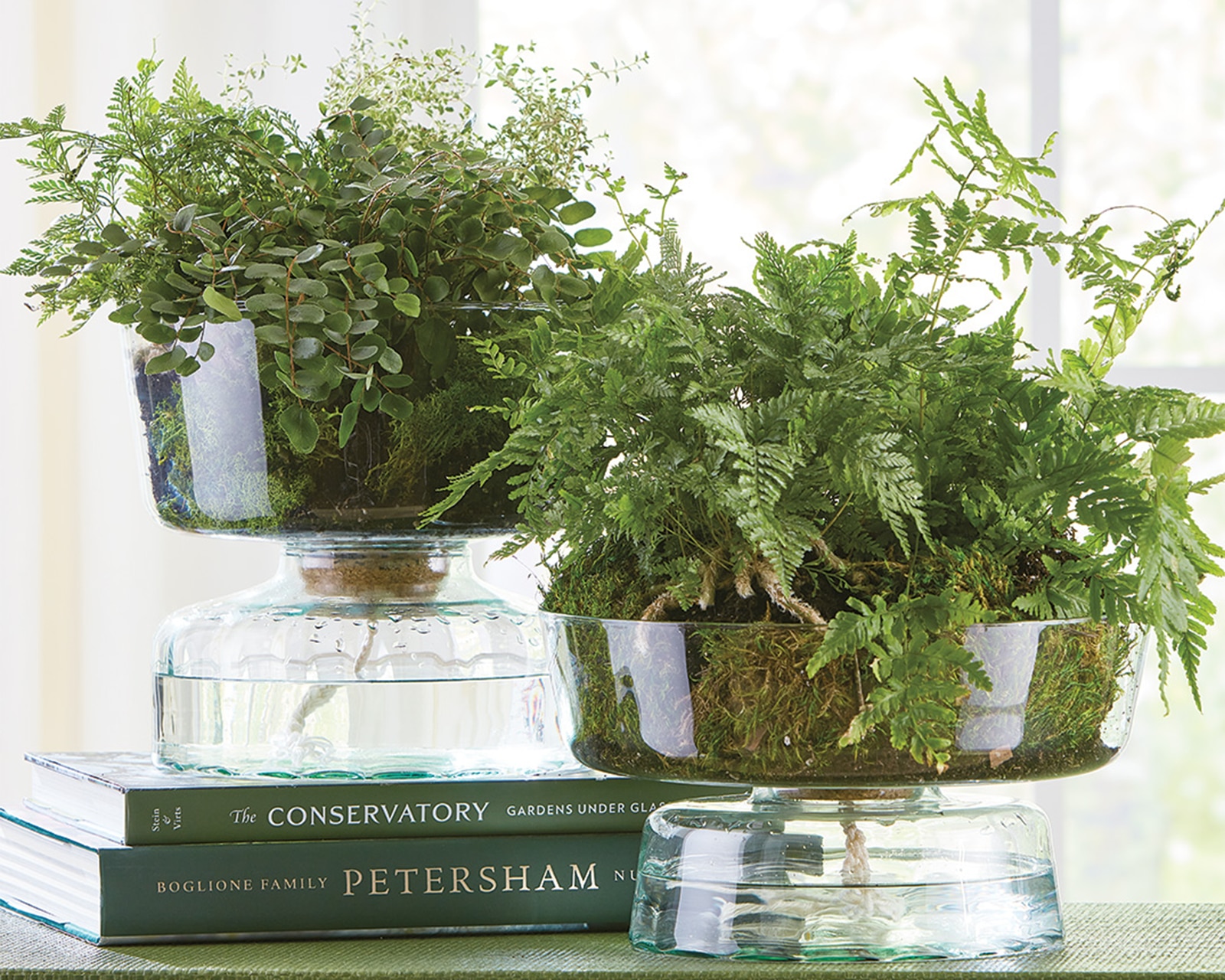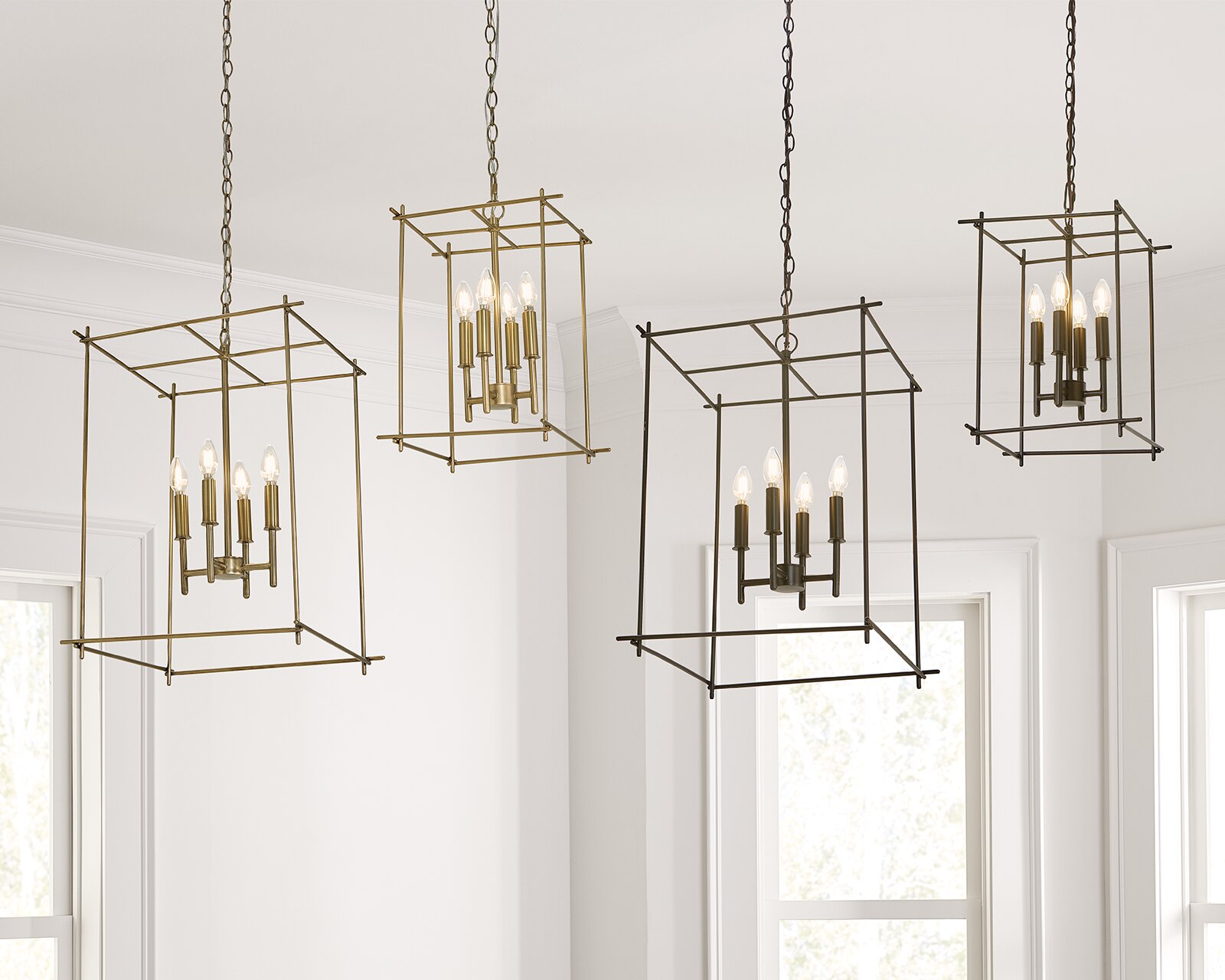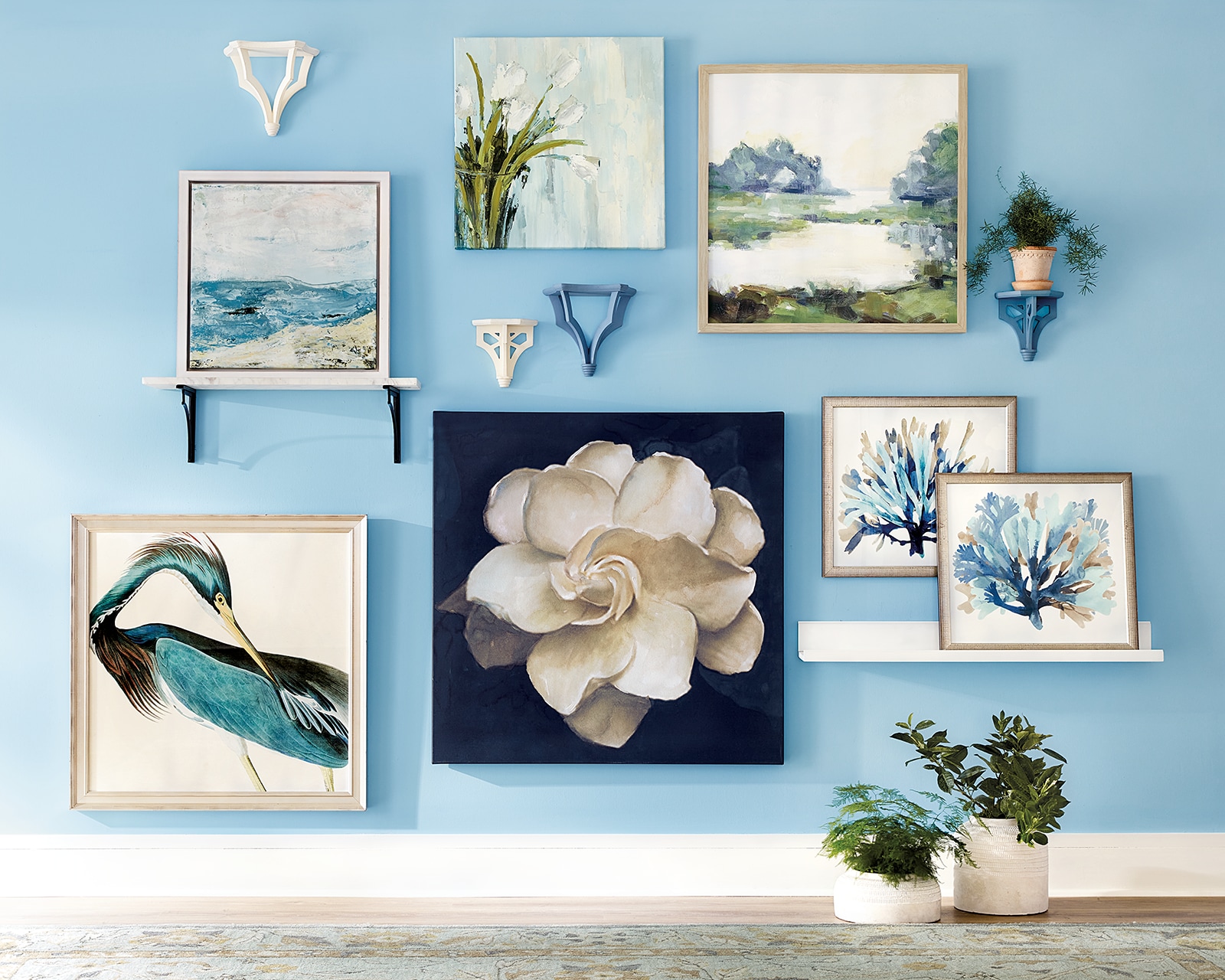This blog about mindful home decorating and its supporting research were last updated February 2023.

There’s nothing quite like escaping to your favorite spot in the home and taking time to be mindful after a long, stressful day… *inhale* *exhale*
We can all agree that our homes should be a place to escape the stress and anxiety caused by the outside world, but you might be surprised to learn just how your home environment (and how you choose to decorate it) affects your mental health.
For example, did you know the wall color of a room affects can alter your overall mood? Or that the temperature of overhead lights can heighten anxiety? And for those green thumbs out there: who knew adding more greenery throughout the home is proven to lessen symptoms of depression?
In this special mindful-focused home decorating blog, we’ll be walking you through the basics of how your home environment affects your mental health and showcasing five specific interior design choices you can focus on to drastically improve overall mental health.
Does decorating your home actually affect mental health?
Short answer: Yes, and in ways you might not expect!
In the same way a cluttered or poorly decorated home can make you feel inexplicably anxious, a clean home with welcoming design choices can amplify feelings of relaxation, joy, and improve your ability to be mindful. Let us explain…

For as long as humans have been decorating our homes, the positive mental health benefits of core interior design choices have been understood and even popularized without any actual research. But when did scientists first begin empirically testing this phenomenon?
Academic interest in mindful home decorating first originated in the 60s and 70s from psychologists studying the effects of building architecture on the human psyche. The more they observed and tested human subjects, the more they began realizing just how interconnected overall building architecture and the elements of interior design inside it actually were [1].
But, in just the past twenty or so years, researchers studying core elements of interior design on mental health have begun noticing consistent results when measuring long/short term effects on symptoms of anxiety, depression, and overall mood—a growing field of study officially known as “environmental psychology.”

What environmental psychology tells us about home decorating:
The focus of environmental psychology research on more specific elements of home décor have been sparse but steadily growing in quantity [2] since the 2010s… and for good reasons.
Although most of the data we came across in our own research were either industry specific or theoretical in scope, the factual, human tested, or peer-reviewed research we did find truly made us reconsider the underlying connections between mental health and home decorating.
There’s a lot we could write about when it comes to this topic, but we boiled it down to covering the five most impactful design choices that have real effects on your overall mental health as well as our favorite resources for learning how you can start maximizing the positive mindful effects of your own home today. Let’s dive in!
5 Key Elements of Home Decorating that Impact Your Mental Health
Although the long-term mental health effects of interior design are still theoretical in scope or being researched by trusted professionals, a few core elements of home decorating have remained the focus of current and historical studies due to the observed impacts they have on overall mental health.
We’ll start with one home decoration that isn’t as obvious as you might think…
#1: Greenery
Here at Ballard Designs, we’re no stranger to decorating our homes with greenery of all shapes and sizes—and not just because we LOVE greenery as a decorating accent.
Controlled studies have consistently proven that a healthy selection of plants throughout a home will boost overall mood, improve concentration, and alleviate stress and anxiety [3]. Even more interesting: studies show a vibrant selection of flowers have been linked to significantly reduced symptoms of depression when used to decorate high-traffic areas of the home. Who would have thought?

If you’re interested in adding more greenery to your home décor—especially to take advantage of its tremendous mental health benefits—here’s a few of our favorite resources to help you get started:
- How to Decorate Your Home with House Plants (Guide)
- How to Use More Natural Elements in Your Home (Guide)
Adding more greenery to your home doesn’t necessarily mean you have to be a professional botanist, however: We love adorning our homes with well placed faux greenery too, and studies show that faux plants boost serotonin levels just as much as the real stuff. Check out our faux greenery decorating guide to see how you can find the right faux plants for your decorating vision!
#2: Lighting
If we had a light bulb for every blog post we’ve dedicated to lighting your home, we’d be able to fill all of our chandelier offerings and still have a few 60w bulbs leftover…
Here’s something we’ve known intuitively for decades but can’t emphasize enough now that we have research to back it up: lighting your home—both in natural and artificial forms—plays a crucial role in your day-to-day mental well-being.
Why? Well, when you aren’t asleep, your brain is actively measuring light and light temperature within your environment to help regulate the body’s natural circadian rhythm (a.k.a., the wake/sleep cycle and natural chemical releases associate with it).
Studies in the past few decades suggest that too much cool artificial light and not enough access to warm/natural sunlight can heighten symptoms of anxiety and depression over long periods of time [4]; Additionally, the physical placement of light fixtures can also exasperate mental health symptoms for better or worse, though it’s not always understood why.

That being said, if you’re interested in adjusting the lighting of your home to avoid any negative mental health side effects, here’s a few crucial decorating tips/resources we recommend to get started:
- Open up natural light to as many rooms in your house as possible: trim down greenery outside of windows, open up usually closed drapes, and incorporate mirrors in hallways to help accomplish this task throughout the home;
- In rooms with absolutely no access to natural light, replace cool-toned artificial lights with warm-toned lightbulbs or lampshades; In rooms with too much natural light, balance the warm tones in the day time with cool-toned light fixtures.
- For an in-depth overview of how to approach decorating your home with mindful lighting, listen to our “Lighting 101” Episode of the How to Decorate Podcast.
- For help with adjusting the placement of light fixtures across your home, give our How to Layer More Light into Your Living Room guide a read as a jumping off point to lighting other important rooms of the house!
#3: Art
They say art imitates life and life imitates art, and that couldn’t be a more truthful sentiment when it comes to mindful home decorating.
Research suggests that including a healthy selection of artwork in your home can activate wide array of mental health benefits in controlled studies [5]: When personalized and displayed with intention, art in the home can alleviate symptoms of anxiety/depression, invoke strong emotional memories, and even slow the progression of neurological diseases like Alzheimer’s [6].

Ready to start shopping for more artwork? Here’s our three most helpful resources for choosing and displaying art around the home:
- Art 101 with Karen Fleenor (Podcast/Guide)
- How to Arrange Artwork (Guide)
- How to Group Artwork (Guide)
Whether you find joy in displaying an obscure collection or get lost in designer paintings like our Bunny Williams Botanical Art, adorning your home with artwork that truly makes you happy is a tremendously influential aspect of decorating proven to improve mental health in both the short and long term.
#4: Furniture Arrangement
With so many styles, spaces, and selections, finding the perfect furniture arrangement can be a tough challenge for any decorator—but what if we told you that the actual placement of furniture and not the furniture itself has a significant effect on your ability to relax?
Although it is still a newer focus in the field of environmental psychology, research has shown that the arrangement of anchor furniture pieces in a room’s layout can heighten the release of chemicals associated with either anxiety or relaxation by directly impacting the amount of cortisol your brain releases [2].
Rooms where furniture is intentionally arranged to be open and foster social interaction are received more positively in controlled studies than cramped/non-social rooms; Additionally, some research suggests that the amount of “traffic flow paths” (walking paths for entering/exiting a particular space) can also impact cortisol release.

Ballard Design’s Free Room Planner Tool
If you feel like your furniture arrangement could be improved or feels cramped, here’s three helpful resources to help you maximize the mindful benefits of welcoming furniture arrangements:
- How to Space Furniture in Your Room (Guide)
- How to Arrange Outdoor Furniture (Guide)
- FREE Room Planner Tool (Decorating Resource)
#5: Color
Finally, we wanted to close out this blog post with one of the most crucial (and least understood) elements of mindful home decorating… color choice.
Similar to research on the mental health effects of home lighting we discussed earlier, the impact of color on mental health is generally divided into two sections: warm colors vs. cool colors.
Even outside of environmental psychology, we know that color choice impacts object perception and overall mood. For example, blue has been shown to evoke soothing/calming feelings in controlled studies while red has been shown to evoke anxiety/alertness [7].
Although research is still limited, the connection between color and overall mood guides many decorating choices in the interior design world and should always reflect your own perceptions when it comes to painting or coloring your own home.

Although connections between color and overall mood exist, we’ll close this section by arguing that more conclusive research is needed before giving any practical decorating suggestions. For now, we’ve selected a few quality blog posts to help you decide what colors work or don’t work with your own style, space, and mindful decorating goals:
- Colorful Rooms: How to Add Color to Every Space (Guide)
- Small Ways to Add Color to Your Room (Guide)
- Schedule a FREE color consultation with our Design Services Program (Helpful Resource)
Unleash your Mindful Home Decorator!
Did you find this mindful decorating guide to be helpful? The How to Decorate writing team can’t wait to start adding more greenery, choosing better lighting, and rearranging our furniture ourselves…
As always, let us know in the comments below what key element of interior design you were most surprised to learn affected overall mindfulness, or let us know if you have any questions about environmental psychology this blog didn’t fully answer!
REFERENCES:
[1] Dolatowski, Calvin. 2021. How Interior Design Impacts Your Mental Health. Accessed 2023. https://desis.osu.edu/seniorthesis/index.php/2021/10/04/how-interior-design-impacts-your-mental-health/.
[2] Graham, Lindsay T., Samuel D. Gosling, and Christopher K. Travis. n.d. “The psychology of home environments: A call for research on residential space.” Perspectives on Psychological Science 10 (3): 346-356.
[3] Floriculture, Ellison Chair in International. 2020. Health and well-being benefits of plants. https://ellisonchair.tamu.edu/health-and-well-being-benefits-of-plants/#.V2LgCbuLTIW.
[4] Boubekri, Mohamed, Ivy N. Cheung, Kathryn J. Reid, Chia-Hui Wang, and Phyllis C. Zee. “Impact of windows and daylight exposure on overall health and sleep quality of office workers: a case-control pilot study.” Journal of clinical sleep medicine10, no. 6 (2014): 603-611.
[5] Bear, Jess. 2012. Interior Design Use in Alleviating Depression and Anxiety. Accessed 2023. https://healthcaredesignmagazine.com/trends/architecture/interior-design-use-alleviating-depression-and-anxiety/.
[6] Seifert, Lauren S., and Melinda K. Baker. “Art and Alzheimer-type dementia: A longitudinal study.” Clinical Gerontologist 26, no. 1-2 (2003): 3-15.
[7] Güneş, Elif, and Nilgün Olguntürk. “Color‐emotion associations in interiors.” Color Research & Application 45, no. 1 (2020): 129-141.






Danita C.
Fascinating and well written article. I enjoyed hearing of all the mentioned ways we can improve our mental health in our homes. Looking forward to your next article on this subject. Thank you!
Kelley Bostian
Hey Danita,
Glad to hear you found this article insightful! There was a lot of more interesting mental health research we wanted to include when writing the first draft, so we will definitely be following this up with a part 2 in 2024.
Stay tuned and happy decorating,
Kelley
Lisa
Decorating makes me happy…and now I know why! This was great. Thanks so much!
Kelley Bostian
Glad to hear you enjoyed reading this mindful-focused decorating blog as much as we enjoyed researching/writing it.
Happy Decorating,
Kelley
Donna N
What great info! I appreciate, also the fact you were not pushing a certain style. Thanks! Very helpful.
Kelley Bostian
Donna,
Appreciate the kind words. Everyone has their own decorating style, and we encourage adorning your home with furniture, decor, greenery, and art that makes you feel the happiest.
Happy Decorating,
Kelley
Sandy
Very helpful and interesting read. I was aware of all but the furniture arrangement effects on mental outlook. Look forward to following the links suggested and learning more!
Kelley Bostian
Sandy,
Excited to hear you enjoyed our mindful decorating research/blog, and love to hear that you’re interested in learning more about this decorating topic.
Check back in the future for an official follow up: there are so many other interesting mindful home decorating suggestions and data we came across in our research that we couldn’t fit in to this initial piece, so we are just scratching the surface!
Happy Decorating,
Kelley
Catherine Marks
Loved this article! I have been preaching these elements for years. Good design is functional, utilitarian and makes you feel good. I love that psychological science is acknowledging environmental impact on our mental health. I have always been sensitive to such things. As a child my grandmother described me as texturally sensitive as “The Princess and the Pea.” I am sharing this article with everyone. Thank you so much!
Catherine Marks
Nest Feathers Design
Kelley Bostian
Catherine,
Glad to hear you enjoyed reading this mindful-focused decorating blog as much as we enjoyed researching/writing it. Research on this topic is still formative, but the factual data we do have as of the writing of this article is very promising for the future of home decorating.
Check back in the future for an official follow up to this topic, and thanks for sharing!
Happy Decorating,
Kelley
Maryanne C
This article was helpful because it wasn’t pushing a popular style. Instead it just gave good information about how decor impacts the people in the room. I will be sharing this and talking about this with friends.
Kelley Bostian
Hey Maryanne,
Thanks for the kind words–I’m so happy to hear you enjoyed reading this article as much as I enjoyed writing it! We’ll be covering mental health & home decorating again later this year, so stay tuned for more.
Happy Decorating,
Kelley